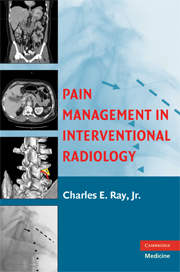Book contents
- Frontmatter
- Contents
- Contributors
- Preface
- Acknowledgments
- 1 Pain Management in Interventional Radiology: An Introduction
- 2 Clinical Evaluation of Low-Back Pain
- PART I LOCOREGIONAL PAIN CONTROL
- 3 Local Anesthetics
- 4 Functional Lumbar Spine Anatomy: A Review
- 5 Percutaneous Vertebroplasty
- 6 Kyphoplasty
- 7 Epidural Steroid Injections
- 8 Selective Nerve Root Blocks
- 9 Discography
- 10 Facet (Zygapophyseal) Joint Injections
- 11 Articular Interventions in Pain Management: A General Approach
- 12 Percutaneous Management of Visceral Pain
- 13 Embolization of Painful Neoplasms
- 14 Image-Guided Ablation of Painful Osteolyses
- 15 Chronic Pelvic Pain in Women
- PART II SYSTEMIC PAIN CONTROL
- Index
- References
12 - Percutaneous Management of Visceral Pain
from PART I - LOCOREGIONAL PAIN CONTROL
Published online by Cambridge University Press: 04 September 2009
- Frontmatter
- Contents
- Contributors
- Preface
- Acknowledgments
- 1 Pain Management in Interventional Radiology: An Introduction
- 2 Clinical Evaluation of Low-Back Pain
- PART I LOCOREGIONAL PAIN CONTROL
- 3 Local Anesthetics
- 4 Functional Lumbar Spine Anatomy: A Review
- 5 Percutaneous Vertebroplasty
- 6 Kyphoplasty
- 7 Epidural Steroid Injections
- 8 Selective Nerve Root Blocks
- 9 Discography
- 10 Facet (Zygapophyseal) Joint Injections
- 11 Articular Interventions in Pain Management: A General Approach
- 12 Percutaneous Management of Visceral Pain
- 13 Embolization of Painful Neoplasms
- 14 Image-Guided Ablation of Painful Osteolyses
- 15 Chronic Pelvic Pain in Women
- PART II SYSTEMIC PAIN CONTROL
- Index
- References
Summary
INTRODUCTION
Pain from the abdominal and pelvic viscera is difficult to manage because it is often secondary to a malignancy or a chronic inflammatory process. A patient with such chronic pain usually needs narcotics to reduce the severity. When tolerance to the medication develops, increasing doses of narcotics are necessary for further pain relief. In addition to the physiological impairment this causes, increasing doses of narcotics can lead to mental and emotional impairment, all of which can significantly reduce a person's quality of life (1). Any therapy that can reduce such dependence while lessening the severity of the underlying pain will be favorable to the overall well-being of the patient.
First described by Kappis in 1919 (2), various methods of percutaneous visceral pain control have been employed since Moore (3) popularized the classic posterolateral approach to the celiac plexus using fluoroscopic guidance. The success of either temporary or permanent pain relief from these methods, along with the relatively low complication rates, justify their mention as viable pain control options for patients with severe or poorly controlled symptoms. Interventional radiologists who understand the anatomy and physiology of visceral pain can use their percutaneous skills to offer an effective and minimally invasive therapy for a disease process that otherwise has a less-than-optimistic course.
VISCERAL PAIN PATHWAYS
Visceral pain can be caused by any process that causes visceral nerve fiber irritation. The classic example is midabdominal pain caused by either pancreatitis or a pancreatic neoplasm (4).
- Type
- Chapter
- Information
- Pain Management in Interventional Radiology , pp. 188 - 198Publisher: Cambridge University PressPrint publication year: 2008



